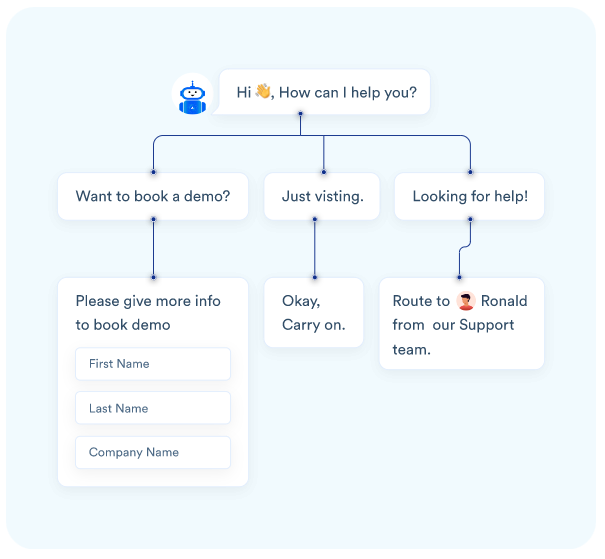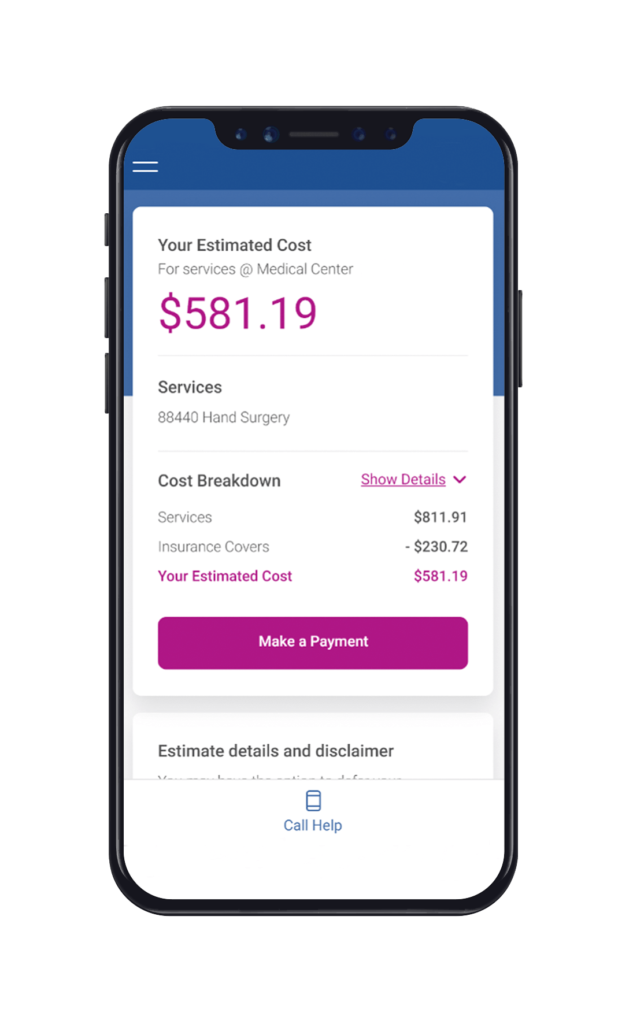Artificial intelligence (AI) in healthcare continues to grow and transform to fit the needs of the industry. In just the next five years, the health AI market will grow more than 10x. AI is transforming healthcare websites by focusing on performing automated tasks that typically require human intelligence. These artificial intelligence technologies are based on data collection, data analysis, and other observations of customer support trends.
With the creation of AI, speed and a good user experience are essential. Customers are looking for an easier way to connect with your organization without requiring an in-person or phone conversation to get the answers and support the need. Integrating AI features into your healthcare website is beneficial to creating a better user experience for your current and future patients and therefore a good impression of your healthcare facility.
Interested in more tips on how to improve your healthcare website? Check out our blog on the “8 Components Your Healthcare Website Needs.
Why is AI important in healthcare websites?
Artificial intelligence is vital to simplify patients, doctors, and administrators’ lives by performing tasks that humans typically do but in less time and at a fraction of the cost. With patients continuing to demand more from their providers, AI increases and drives improvements in customer care. Let’s take a look at some of the benefits of incorporating AI functionality into your healthcare website.
Improve the user experience
Having a great patient experience is critical to your ability to attract and retain patients.
Patients who trust their healthcare providers and form positive relationships become more committed to their own care and develop stronger loyalty to your organization. Your website is an extension of your healthcare facility, and your patients should feel as though they are receiving the same service online as in person.
AI tools like chatbots and telehealth services (to give two examples) can be useful tools to provide a more engaging user experience on your website, as they can replicate similar experiences to communicating with a real person, in person. By making it convenient for your patients to access support and engage with your business online, these tools in return help healthcare providers build relationships, increase brand trust with their patients, and therefore build a loyal customer following.
Save time
In Healthcare, time is of the essence. With the use of artificial intelligence, doctors and patients are able to analyze vast amounts of data in a blink of an eye. 74% of marketers claim that the most significant benefit of automation is saving time. A task that would typically take hours of human labor is accomplished by using automated artificial intelligence tools. Save time by using AI tools like chatbots and email workflows to automate low-level and time-consuming tasks such as scheduling appointments, answering patient questions, and reaching new patients.
Predictive analytics
Predictive analytics is also an essential tool in the Healthcare field. This tool approximates the probability of a conclusion based on historical data discoveries – a massive step forward for many personalized health organizations. According to a 2019 survey from the Society of Actuaries, 42 percent of companies have improved satisfaction using predictive analytics. This AI feature allows clinicians, financial analysts, and administrative personnel to get a “heads up” about possible circumstances before they happen and make forward-thinking decisions about continuing. Predictive analytics can also be used with your website through the use of suggesting blogs or resources that your user may need.
Uses for AI in healthcare websites:
Patients should have the option of receiving care in a variety of ways — chatbots, telehealth visits, in-person consultations, etc.— ultimately boosting their confidence in and loyalty to their healthcare provider. By adding several AI tools and AI best practices to your website, you’re providing your patients with the tools they need to fully engage with your organization.
Chatbots
A chatbot is an AI feature that allows you to communicate via automated messages to solve a problem or answer a question about your website or company. Natural language processing and machine learning work to process data to accurately communicate via the chatbot. Chatbots are enhancing some of the traditional customer services to serve as 24/7 communication with potential patients.
Available 24/7
When a customer visits your website, they should have the same experience whether it’s during business hours or not. And most likely, your patients will be researching their healthcare options any day of the week at any time of the week. Chatbots are an excellent way to be “available” at all times and continue to save 20-40% of the website viewers who would visit during non-business hours.
Support
Chatbots can automatically answer your patient’s questions, provide recommendations, or direct them to the next step in your workflow, therefore taking much weight off your customer support system. Chatbots are also immune to the frustration and stress from unruly visitors to the website.
Human experience
In the healthcare industry, chatbots can work to access patient concerns, such as accessing their symptoms. Characterizing the chatbot as intelligent, supportive, and empathetic will help create a human-like representation. These three characteristics are what people look for in a caring figure to replicate the in-person experience as close as possible. A recent study published in the Journal of the American Medical Informatics Association found that chatbots in healthcare are most helpful when the chatbot’s ability, patient compliance, integrity, and benevolence match that of a human agent.
Intelligent scripting
Healthcare companies should integrate their AI chatbot with a script that allows it to follow a guided path presented to users through a button-click format. This button format will make it easier for patients to receive correct diagnoses or solutions from the scripted process. A scripted process requires a setup based on a specific industry such as healthcare. This script could help schedule appointments, answer questions, or provide a diagnosis to minor ailments.

Overall, 75% of businesses using chatbots on their website report at least a 10% boost in customer satisfaction.
Chatbot tools
Your chatbot should work to add benefits to your patients’ overall user experience. Chatbots should focus on instant responses and easy communication, and have the ability to answer simple questions and resolve user complaints.
Infermedica is an example of a machine learning technology chatbot that would make a great addition to your healthcare website. It has the ability to assess the user’s health status and can give a diagnosis and recommendations based on the symptoms the patient provides in the chat. These features provide a seamless experience for your user and help to convert them to a patient.

Online Appointment Scheduling
One of the primary ways to schedule doctor appointments is through phone calls. However, this makes it difficult for patients to schedule appointments after hours. About 56% of patients have expressed frustration with inconvenient office hours or waiting on hold to book an appointment.
User experience
Provide a better user experience for your patients by offering a self-service 24/7 online appointment scheduling feature on your website. This type of feature allows your patients to easily and quickly book their own appointments when it’s convenient for them, without the need for a medical staff member to help.
Streamline appointment scheduling for staff
Not only does an online appointment scheduling tool benefit your patients by making it easy for them to communicate with your business but it can also help medical staff manage and organize their doctor’s appointment schedules. Scheduling appointments is a critical part of the healthcare professional’s daily work, so using an online appointment scheduler can help them save time booking individual and recurring appointments while still being able to manage their patient records.
Some of the best practices for using an online scheduling tool on your website include having a simple and straightforward design, including a clear CTA at the top of your page as well as in your navigation for easy access, and integrating the option to book an appointment from within your chatbot.
Online scheduling tools
Programs such as Calendly help to provide a quick and easy way to schedule appointments online. The online scheduler provides dates and times available to sign up for an appointment. It can also include a refined schedule based on the business hours or a blocked-off lunch or holiday.
Healthcare cost estimators
According to modernhealthcare.com, “For the most part, consumers remain in the dark about what they will be asked to pay after visiting a primary-care doctor or undergoing an inpatient procedure.” A healthcare cost estimator allows patients and prospective patients to know what bills to expect when coming in for an appointment. This AI feature takes into consideration the patient’s insurance policy and other particulars of his or her case.
Transparency and trust
It is important to include a healthcare cost estimator on your website because it makes it easy and convenient for patients to know upfront their estimated costs during their initial research. This level of transparency can help strengthen your patient’s trust in your organization and as a result, make them more likely to choose your healthcare practice over one that is not upfront about their pricing.
Healthcare cost estimator best practices
Some best practices to include in your healthcare cost estimator include cost breakdowns, limiting time and steps to reach the end, providing multiple pathways to estimate, and having that it is only an estimation. These different essential practices will help to make your cost estimator easy and quick to use. Also, when designing your website, place the cost estimator in the navigation bar to make it easy for your patients to find.

Learning algorithms
Learning algorithms learn and develop to fit your patients’ needs and wants over time.
Healthcare organizations and patients are seeing this advancement as AI tools take in symptoms provided by the user and give a diagnosis in return. Your medical website also can use website IP addresses to locate the user and present information specific to them, such as physicians and practices local to their area. Patients will receive content tailored to their preferences by developing targeted artificial intelligence solutions.
Predicting patterns in customers
Medical websites can also use AI tools to pull custom content from the web to allow visitors to dive more deeply into the given topic. This type of feature uses past behavior and usage patterns to present conditions or treatments and can make suggestions based on the patient’s demographics and past behavior. When visitors ask for more information about conditions and treatments, the predictive AI tool will grow more intelligent and learn more about the field requested.
Targeting Customers with Learning Algorithms
Targeted information is important to include on your website because it helps to address a specific clientele better. These learning algorithms tools like Altair can be used to help transform your medical website into a trusted information source for your patients. Especially in the Healthcare field, having a website that aids and supports potential patients is the key to growing your online presence.
Telehealth
COVID-19 has forced medical companies to find alternative ways of providing healthcare while limiting exposure to the disease. With the pandemic raising major concern, telemedicine presented itself as an ideal solution for limiting patient displacement and allocating hospital capacity to important cases, as well as curbing the spread of the disease. During the first quarter of 2020, the number of telehealth visits increased by 50%, compared with the same period in 2019.
Telehealth is an online AI format that allows doctors to provide live healthcare services and information to patients online via phone, video chat, or instant messaging.
The adoption of telemedicine has increased significantly in the last decade as approximately more than 70 percent of urgent illness conditions can be taken care of with the help of telemedicine. Since the start of the pandemic, the adoption of telemedicine shifted into hyper-drive, with virtual health-care interactions on pace to top 1 billion by year’s end.
Rise in patient adoption
With virtual care adoption on the rise, telehealth features and functionalities on healthcare websites have shown to be a necessity in growing your practice. 67% of patients said that using telemedicine services would increase their satisfaction with medical care. The use of telehealth caters to a new audience of online users. Entering this market requires your company to be up to date with websites and AI best practices to ensure your patients have a good experience with this new service.
As telemedicine continues to rise, the need to inform people of your virtual services and the need to make it easy for people to find your services on your website is crucial.
Keep content above the fold
Users typically spend less than 15 seconds on your site. Because telehealth is showing high adoption, it’s important that your high-value services are towards the top of your website so they can quickly see it before leaving your site.

Mobile-responsive
The number of people spending time on mobile devices has increased 70% worldwide since the coronavirus outbreak. Be sure to provide a good experience by making sure the telehealth feature on your website is also mobile-responsive.
Improve website messaging
Let your audience know you’re providing virtual doctor visits by making it easy for them to learn about the services and how they can access it. Provide a button or banner at the top of your website that says “Offering Telemedicine Now” that links to a page with more information or add an option in your chatbot to “Schedule a Virtual Appointment” that links directly to your scheduling software.
Examples of telehealth software
A couple of platforms that are useful for Telehealth include SimplePractice, Web PT, Mend, and more. These platforms look to follow the four features including HIPAA compliance, multi-provider practice, one-to-one Messaging, and practice management. Researching and demoing these products will help to find the perfect platform for your practice.

AI in healthcare websites concerns
Although implementing AI tools in healthcare websites has proven to be a worthwhile endeavor considering the benefits it brings not only to your patients but your healthcare organization as well. There are still some concerns your organization should be mindful of.
Incorporate the human experience
At the end of the day, your patients still want a human experience. While AI can help alleviate time-consuming tasks so your team can focus on more high-priority tasks and can also help scale your business as you focus on expanding the pipeline, AI is not intended to replace all human interactions. Keep this in mind when implementing AI tools and strategies on your website to make sure at some point your patients have the ability to speak with a real human if they need to.
Find the right platform
There are also a variety of various AI platforms available for the healthcare industry right now. Choosing the right platform for your business is critical to the performance of the AI. Researching and testing our products is the best way to determine the best outcome for your healthcare business.
Privacy compliance
There is also an issue with using AI with federal laws such as HIPAA, and patient privacy is at risk. As healthcare AIs grow more complex and their decision-making patterns more opaque to human care providers, it will grow increasingly difficult to determine when, where, how, and even if they are doing anything that might fall under the HIPAA umbrella. The use of AI will likely in the future be subject to regulations that protect patient information.
Partner with Pyxl
Do you need help bringing your Healthcare business to the world of AI? Pyxl has a team of professionals who consistently research and learn new technologies to better our clients. Contact us today to get started.
Updated: Jul 18, 2024
 Bonnie Winter
Bonnie Winter
 Kati Terzinski
Kati Terzinski